 Available year-round here in California, cabbage is a perfect budget-friendly choice for salads, soups, stews and roasts. It’s also a superfood! A member of the Cruciferae family (along with kale, broccoli, collards, and brussels sprouts), there are over 400 cabbage varieties available with the three most familiar being green, red, Napa and Savoy. With their high levels of antioxidants (vitamin C, manganese), polyphenols, and sulfuric compounds, cabbage plays a large role in reducing inflammation and in the prevention of cancer. This is some fantastic news since cancer is on the verge of overtaking heart disease as the No. 1 cause of death. Cabbage contains a variety of nutrients of potential benefit to our stomach and intestinal linings and those which help regulate our microbiome (more on this fascinating topic in a future post!). Finally, their high fiber content helps to lower our cholesterol and aids in our achieving a healthy weight! I can go on and on…..but I will stop. Per the research, it is suggested that adults aim for at least 5 weekly servings of cruciferous vegetables. So now....how to add more cabbage (and other cruciferous veggies) into our diet?? Every Saturday Albert and I visit out local farmer’s market and cabbage is always on the menu. Below are my three go-to cabbage recipes plus one I would like to make more of. Try these babies out and let me know how you like ‘em! And please, share with me in the comments section below YOUR favorite cabbage recipes! I'm all ears! Roasted Pork & Cabbage I made this recipe up and therefore have never recreated it exactly, but it's OK since every time I make it again it still blows my mind! (Just make sure not to overcook the tenderloin!)
Emeril Lagasse’s Chipotle Slaw This recipe accompanied in his fried catfish taco recipe (which is delicious baked!). When we first made this recipe, the slaw was the true star and I now make it at least bi-weekly. Great with any grilled/baked protein! Chipotle Slaw 2 teaspoons chipotle chiles in adobo, finely chopped (found in the canned foods section at any grocery store) 1/2 cup mayonnaise 2 tablespoons honey 1 tablespoon lime juice 1 cup white cabbage, shredded 1 cup red cabbage, shredded 1/4 cup red onion, finely chopped 1/4 cup green onion, chopped Spicy Buckwheat Soba Noodle Salad with Thai-Style Peanut Dressing Buckwheat is a great source of fiber and manganese and a provides a more nutty taste than wheat pasta. The peanut dressing in this recipe is finger-licking good and I typically add twice as much carrots and cabbage! Though it might take a few ingredients you may not have typically have on hand, like red curry paste, once you make the investment you’ll be inspired to find more recipes to use them up! I love making red thai curry with kabocha squash with the extra curry paste myself! Homemade Sauerkraut (Kapusta) Fermented foods are powerhouses that contain beneficial probiotics, digestive enzymes, and health-boosting nutrients. I have had the honor of making Kapusta with Albert's folks before and aspire to make this tangy and healthful fermented food myself more often. Perhaps this weekend...
6 Comments
 Fiber. It’s one of those nutrients we often hear about, but did you know that most Americans are deficient in it? Public health guidelines from the US Food and Drug Administration (FDA) advise Americans to eat between 20 and 38 grams of fiber a day, but most adults don’t even eat half that much. This post will describe what fiber is, its fabulous health benefits and how we can ramp up our intake. (And I promise you won't grow a sunflower out of your bum!) Dietary fiber is basically the parts of plant foods that our bodies can't digest or absorb. It passes relatively intact through our stomach, small intestine, colon and out of our body. Fiber is present in all plants that are eaten for food, including fruits, vegetables, grains, beans, lentils and peas. Though there are many types of fiber, they are generally categorized as either “soluble” or "insoluble”. Soluble fiber dissolves in water to form a gel-like texture, helping to slow down your digestion and make you feel full. These fibers help lower cholesterol and help regulate blood sugar levels. Soluble fiber is found in oats, lentils, apples, oranges, pears, strawberries, nuts, flaxseeds, beans, dried peas, blueberries, psyllium, cucumbers, celery, and carrots. Insoluble fiber does not dissolve in water and adds bulk to your stool and speeds up the passage of food and waste through your gut, helping prevent constipation. It also helps regulate your intestine’s pH. It is found in whole grains such as whole wheat, barley, brown rice and bulgar, nuts and seeds, zucchini, celery, broccoli, cabbage, onions, tomatoes, carrots, cucumbers, green beans, dark leafy vegetables, raisins, grapes, and root vegetable skins. Most plant-based foods, such as oatmeal and beans, contain both soluble and insoluble fiber. However, the amount of each type varies in different plant foods. Eating a wide variety of fibers is the ideal solution to gaining all the health benefits. Benefits of a high-fiber diet:
Ways to boost your intake: We should get at least 20 grams of fiber a day, but more is better. Slowly adding more fiber to your diet can avoid bloating and gas by giving your body time to adapt. It is also important to drink plenty of liquids while increasing fiber.
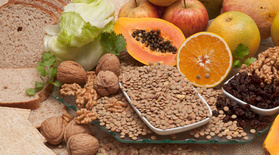 Last week I introduced research indicating that the risks of diseases such as type 2 diabetes and coronary heart disease are strongly related to the glycemic index (GI) of our overall diet. Typically foods with high GI’s are high in sugar and/or starch (think desserts, white flour, cereals, rice, potatoes). But what can we do to lower a foods impact on our blood sugar if we do choose to eat a cupcake or some potato chips (preferably baked - here's a great recipe I use), which are high-GI foods? I recently finished reading The Sugar Blockers Diet (thanks for the recommendation Ilana!) and learned about sugar blockers, or ways we can slow the absorption of glucose into our blood stream. These various means to block sugar are powerful since, according to research in the book, reducing the size of after-meal blood sugar spikes by just 30% reduces insulin demands, promotes weight loss, makes diabetes easier to control and can actually reverse prediabetes. If knowledge is power, here’s to power! Sugar blocking power! 1. Increase particle size: Ways to increase the size of carbohydrates particles that reach your stomach. Example: Cook your pasta al dente, or slightly undercooked. It will take longer to digest and raise your blood sugar less than if you over cook it. Try it out and let me know how you like it! 2. Stomach barriers: Things you can do to physically impeded the passage of carbohydrates from your stomach to your intestine. Example: Eat something fibrous (like a salad) before your meal. 3. Intestinal “brakes”: Substances that slow stomach emptying. Example: Eat a handful of nuts or a piece of cheese before a meal. 4. Enzyme inhibitors: Substances that inhibit enzymes that break down starch into sugar. Example: Amylase is a digestive enzyme that breaks down starches into smaller carbohydrate molecules. It is secreted by our salivary glands and pancreas. Vinegar inhibits amylase and is thus a sugar blocker. Eat a salad with a vinegar-based dressing to lower your after-meal blood sugar level. Vinegar-based dressings are always a healthy choice over cream-based and they're so easy to make! I make this balsamic vinaigrette often. 5. Sugar sponges: Substances that soak up glucose in your digestive tract. Example: Foods or supplements high in soluble fiber (found in legumes like beans and peas, oats, seeds and nuts, some vegetables and fruit). I will discuss the different types of fiber in depth in my next post. 6. Liver helpers: Substances that enhance your liver’s ability to take up glucose released into your bloodstream during meals. Example: Our liver is our second largest organ that performs many essential functions related to digestion, metabolism, immunity, and the storage of nutrients within the body. Alcohol helps the liver take up glucose after you eat, so enjoy a glass of wine or even a shot before your meal. I personally love beer, but it tends to have more carbs than wine or liquor so choose wisely and watch for portion sizes. 7. First-phase simulators: Ways to get the beta cells of our pancreas to secrete insulin sooner rather than later, making it more effective. Example: Protein triggers the first-phase insulin response, so eat an egg with your toast or meatball with your spaghetti. 8. Insulin sensitizers: Techniques that sensitize your body to insulin so that less is needed to handle the after-meal glucose surge. Example: Reduced sensitivity to insulin is a major contributor to type 2 diabetes. The one cure for insulin resistance is exercise, so be sure to exercise every 24 to 48 hours. A 20 minute walk is sufficient. Resistance exercises (lifting weights, pushups, pull-ups, etc.) are effective too since the more muscle cells we have the more glucose they absorb. 9. After-meal exercise: Taking advantage of your muscles’ ability to remove sugar from your bloodstream without insulin. Example: Taking a walk after a meal.  "With enough butter, anything is good." - Julia Child I thoroughly enjoy butter. Sauteing a mirepoix, on toast with ikrá (roe), cooking eggs, in baked goods….salty, sweet with its creamy mouth feel…delightful. But it has such a bad rap, doesn't it? The purpose of my blog article today is an attempt to redeem butter. Cardiovascular disease is the leading cause of death in the United States, claiming 631,636 lives in 2006 and accounting for more than 1 in 4 (26%) of all deaths that year. Risk factors for cardiovascular disease include high blood cholesterol, hypertension, diabetes, obesity/overweight, and poor diet. The role of butter -- and other high-fat dairy products -- in raising cholesterol levels is debated among scientists. Many mainstream nutrition authorities conclude that butter is bad for cholesterol levels. However, a recent review in the Advances in Nutrition journal conclude that though butter increases LDL (low-density lipoprotein aka “lousy”) cholesterol, it also increases HDL (high-density lipoprotein aka “healthy”) cholesterol and therefore might not affect or can even lower our total cholesterol ratio. Other research confirms that there is no significant evidence concluding that dietary saturated fat is associated with an increased risk of cardiovascular disease. Additional research even suggests bioactive properties of dairy fat and their role in reduced adiposity. Though daunting to read, Good Calories, Bad Calories by Gary Taubes is a great resource that addresses this low-fat conundrum and details the compelling case that refined carbohydrates are in fact the primary cause of weight gain and “diseases of civilization” such as heart disease, hypertension and diabetes. More about that in a later post. The jury may still be out, but I do not fear butter. However, before you start cooking Paula Deen style do understand that butter and high-fat dairy products are high in calories, which we all need to be mindful of for successful weight maintenance. One last note: not all butter is created equal. Mike’s Daily Apple did a great review of grass-fed vs. grain-fed butter regarding its health composition and taste. Grass-fed was the winner with a higher vitamin content, better fatty acid composition and better taste. Kerrygold is an example of grass-fed butter you can purchase at most grocery stores, in addition to Organic Valley Pasture Butter. Finally, it is also important to keep in mind that many toxins are stored in animal fat. According to the FDA, most human exposure to dioxins comes from food, with 95 percent of that coming from animal fats. Ahh…though I do love butter so, there is still a call to my favorite mantra about moderation. Enjoy your butter, buy good quality butter, but use it judiciously. 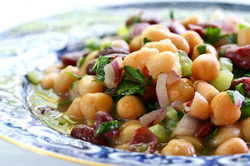 We all know the catchy childhood songs about beans: Beans, beans, the magical fruit The more you eat, the more you toot. The more you toot, the better you feel So let's eat beans with every meal! Or Beans, beans, they're good for your heart The more you eat, the more you fart. The more you fart, the better you feel So let's eat beans with every meal! As odd as it sounds, beans are technically a fruit and a recent research study has once again confirmed their being good for your heart. More than just a meat substitute, beans are rich in antioxidants and high in fiber – with one cup of cooked beans (two-thirds of a can) providing about 12 grams of fiber, nearly half our recommended daily dose*. Beyond their contribution of fiber and disease-fighting antioxidants, a diet emphasizing beans (about 1 serving daily) has been shown to significantly lower LDL (low density lipoprotein or "lousy”) cholesterol levels. If you don’t know much about LDL cholesterol, this is good news as high LDL levels are associated with heart disease. If your next physical involves a blood test, a LDL of less than 100 milligrams per deciliter (mg/dL) is optimal. If your LDL levels are high, watch your intake of saturated fats and ensure to get enough fiber. Regular aerobic exercise also lowers LDL cholesterol and increases HDL (high density lipoproteins or "good") cholesterol to boot. Alrighty then, whose ready for some hummus and veggies? Easy ways to boost your bean intake:
*Dietary Fiber requirements for healthy adult males is 38gm/day, and 25 gm/day for adult females. 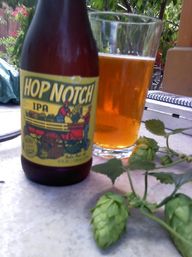 I spent last weekend in Boonville for their annual campathon and beer fest so figured I would write a post on the health benefits of beer. Before my short stint at the Bistro in Hayward, I was unaware of the delicious variety of beer and its warm community. In October of 2008 I worked at their annual wet hop festival and it forever elevated my palate to the IPA-loving woman I am today. Moylan’s Wet Hopsickle was the drink that sealed the deal for me. I love beer for its delicate balance of sweet malt and bitter, fragrant hops, but knowing its health benefits* sure help justify my imbibing: Beer and your bones Beer is rich in silicon, a trace element that plays an important role in bone formation, bone density and connective tissue health. During the mashing process, silicon is made readily bioavailable. Other dietary sources of silicon include whole grains, fruits and vegetables such as green beans and bananas, and legumes. Fiber Beer and fiber? Made from barley, beer contains beta-glucans — a type of soluble fiber credited with improving heart health by lowering cholesterol levels. A 12 ounce bottle of lager sports 0.75 grams of fiber while the same amount of dark beer boasts 1.3 grams. It’s vitamin B-licious Beer is an excellent source of B vitamins such as folate, niacin, riboflavin, pantothenic acid, B6 and B12. One 12-ounce beer supplies 3% of the B12 and 12.5% of the B6 you need in a day. These nutrients support your body’s metabolism and help it produce essential substances, such as neurotransmitters and red blood cells. Heart healthy Those who drink one to two alcoholic drinks of any kind are less likely to suffer from heart disease. Experts believe alcohol improves heart health by making blood less “sticky” so it's less likely to clot by increasing levels of good HDL cholesterol while lowering unhealthy LDL cholesterol. Hops fight cancer Hops are an acquired taste for some, but reconsider their bitterness and in return get a dose of cancer-fighting antioxidants! Hops contain the flavonoid compound called xanthohumol that has interesting cancer chemopreventive properties (i.e it inhibits, reverses or retards tumor growth). I will leave you with the Oatmeal’s 20 things worth knowing about beer. Gotta love this comic. *Most of these health benefits pertain to moderate drinking, 1-2 drinks per day. Beer's calories and carbohydrates also pose a dilemma for those striving to manage their weight. The average light beer has about 110 calories per bottle while a pint of flavorful craft beer can have up to 250. But how much flavor are you willing to sacrifice to save a few calories? In my opinion, life is too short for crappy beer. Drink mindfully, keep active, get enough sleep and don’t stress about it. More on managing calories in another post. 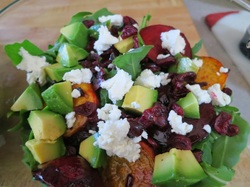 There is compelling evidence that a diet rich in fruits and vegetables can lower the risk of heart disease, stroke and cancer (with those eating seven or more servings daily showing lowest risk). Fruits and vegetables are also a great tool in weight control as they are naturally low in fat and calories and are filling. But how much is enough? The latest dietary guidelines call for six to twelve servings of fruits and vegetables a day (3 -6 cups), depending on one’s caloric intake. However, according to the Centers for Disease Control and Prevention (CDC) 2013 State Indicator Report on Fruits & Vegetables, adults in the US only consume fruit about 1.1 times per day and vegetables about 1.6 times per day. An easy way to remember all this is to echo the MyPlate mantra: make 1/2 your plate fruits and vegetables. Colors count too. It may sound corny, but as I told all the kiddos during my years in the field as a Child Health & Nutrition Specialist, we’ve got to “eat a rainbow a day”! Many of those disease-busting antioxidants are phytochemicals, which provide the varied pigmentation of fruit and vegetables. Incorporate the whites, deep oranges, purples, yellows, reds and greens. Green leafy vegetables are in fact most strongly associated with a reduction in risk of cardiovascular disease. Not quite at that 7+ a day mark? Here are some great ways to incorporate more fruits and veggies into the meals you’re already making: Boost your breakfast: - Add peppers, tomatoes, mushrooms or onions to your eggs for a delicious omelet, or pile the whole scramble on your favorite bread, tortilla, or bagel for a hearty breakfast sandwich. - Stir berries (fresh or frozen), dried fruit, or banana slices into yogurt, cereal, or oatmeal. - Make a smoothie. Combine some low fat milk or yogurt, 1/2 cup frozen berries and a banana for a super easy blended breakfast (add some spinach or kale for a super boost! Nut butters are also a divine addition) . Half the meat, double the veggies: In soups, salads, pastas, sandwiches, pizzas, and casseroles half the amount of meat and double the amount of veggies. You’ll be saving money and filling up with heart-healthy antioxidants and fiber. Do the dip! Go sweet or savory with apple wedges, pears, bananas, mango, or pineapple spears in fruit-flavored yogurt or go with raw veggies and hummus, creamy ranch, avocado, or zesty salsa. Salad time! Make your salad a meal by combining an array of colorful greens (let’s move past romaine y’all), crunchy veggies like carrots, radishes and cabbage with protein (nuts, beans cheese, egg, chicken, tuna,etc.). Beware of dressing overload by keeping it on the side. Keep produce where you can see it….that way you’ll be more likely to eat it. Keep your fruit bowl loaded on the counter, ensure pre-cut veggies are ready to go in the fridge and keep trail mix on hand in the car for an on-the-go snack. Don’t forget the freezer: Pre-cut fruits and vegetables are abundant and affordable options. Plop those frozen fruits into your blender or in your homemade baked goods and add those veggies to your boiling water when making pasta, rice, quinoa etc. 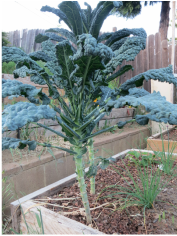 Busy weekend and I'm happy to finally be home relaxing and cooking up some goodness. First thing I made when I walked in the door was Giada De Laurentiis' easy beet, arugula and goat cheese salad...pure bliss. Of course, its only easy when you have all the ingredients on hand. More on a well-stocked kitchen in another post. What I want to write about though is the second dish I made this afternoon: kale chips. Easy, undeniably nutritious and delicious! Albert's green thumb has yielded a very generous plant this year. It's a warm day so soup, in which kale is a great addition, really isn't an option. Hence, kale chips. But what is all the buzz around kale? Kale is considered a “superfood” because it's so nutritionally dense and full of antioxidants (vitamins A, C, K and flavonoids), anti-inflammatory nutrients (vitamin K and omega-3 fatty acids), and anti-cancer nutrients (vitamin K and glucosinolates - compounds responsible for the bitterness in greens). In addition, one cup of chopped kale contains 33 calories and 20% of the RDA (Recommended Daily Allowance) of dietary fiber, 9% of the daily value of calcium, 71% of vitamin C, 98% of vitamin A, and a whopping 1180% of vitamin K*. It is also a good source of minerals copper, potassium, iron, manganese, and phosphorus. Pretty exceptional! (All those stats came from the website Worlds Healthiest Foods - cheesy title, great resource) You can buy a $5 a package of kale chips from a health food store, but a $2 bushel will easily yield three times as many chips. Of course growing the kale is most economical. If you have an hour on your hands, homemade kale chips are king. The simplest recipes call for just olive oil, salt and pepper. I prefer mine rich with roasty tahini. Any nut butter works, actually. Here you go, my Tangy Tahini kale chips, adapted from Savory Simple's Spicy Tahini Kale Chips. Enjoy! Tangy Tahini Kale Chips 1 large bunch of kale, inner ribs removed (lacinato kale aka "dinorsaur" kale is my favorie) Juice from 1/2 lemon 4 cloves garlic chopped (more or less, to your preference) 1 Tbsp extra virgin olive oil (I used homemade chili oil, its easy to make your own!) 2 heaping Tbsps tahini 1/2 tsp honey Generous sprinklings of crushed red pepper flakes, salt and pepper Preheat the oven to 200 degrees F (or plug in your dehydrator). Line 2 baking sheets with foil or parchment. Wash and thoroughly dry the kale, then remove the leaves from the tough inner stem. Slice or rip into large pieces. In a small bowl, whisk together the remaining ingredients. Toss in Kale and mix with your hands. Spread the chips in a single layer on the baking sheets or in the dehydrator. The dehydrator should take approximately 8 hours. The oven will take less than an hour (start checking on them after 30 minutes). They're ready when the seasonings are completely dry and the kale is crispy. *Eating a diet rich in the powerful antioxidant vitamin K can reduce the overall risk of developing or dying from cancer, according to a study in the American Journal of Clinical Nutrition. Vitamin K is abundant in kale but also found in parsley, spinach, collard greens, and broccoli. |
AuthorHello and welcome! My name is Andrea Notch Mayzeles. I am a Certified Health Education Specialist, Mom, and Master of Public Health dedicated to the path of well-being. As a wellness professional I am committed to continued learning and am here to share research, recipes and musings on health, psychology, personal development, and parenting. I hope you enjoy! Categories
All
|


 RSS Feed
RSS Feed